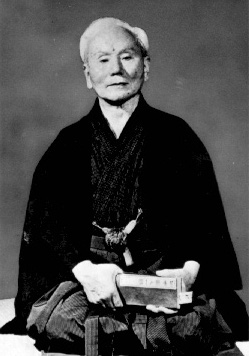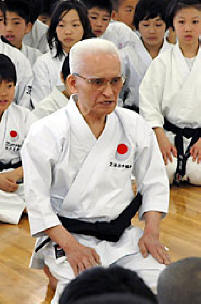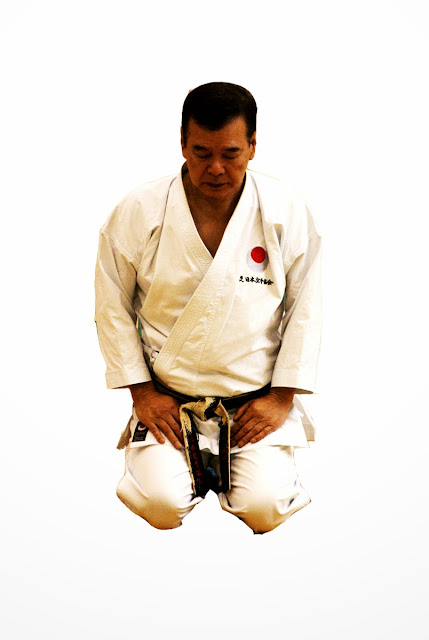Supreme Master Funakoshi Gichin (1868-1957)
The Father of Modern Karate
Funakoshi Gichin was born on Nov 10, 1868 in Yamakawa, Shuri, Okinawa Prefecture. He was of samurai lineage, from a family which in former times had been vassals of Ryukyu Dynasty nobles.
By age 11 he had already made a name for himself in Ryukyu-style martial arts. Beginning his training under Master Azato Anko, it wasn’t long before he equaled his master in ability, and shared with him the distinction of being the “most accomplished” martial artist in the field. He also learned karate-jutsu (written with characters that mean “Chinese-hand martial art”) from Master Itosu Anko. Both his teachers were impressed by his nobility of character.
As over the years he pursued his training and continuously developed his remarkable skills, Master Funakoshi became chairman of the Okinawa Martial Arts Society, as well as an instructor at the Okinawa Teacher’s School. Then in 1922, when he was 54 years old, he introduced Okinawan karate-jutsu at the first Ministry of Education (now Ministry of Education, Science, Sports, and Culture)-sponsored Physical Education Exhibition. This introduction, the first ever public display of karate-jutsu in Japan, was a stunning success. And the previously unknown martial artist Funakoshi Gichin rose to instant fame throughout the Japanese world of martial arts.
Immediately the founder of modern judo, Kano Jigoro, invited Master Funakoshi and his pupil Gima Shinkin to the Kodokan judo dojo to give a demonstration of kata. The highly-attended event filled the Kodokan dojo to capacity. It was so well-received that Master Funakoshi found himself pressed on all sides to stay in Tokyo.
Excited by the opportunity to further promote the martial art that he had done so much to introduce to Japan, Master Funakoshi subsequently began teaching it at Tokyo’s Meiseijuku, a dormitory for Okinawan students there. In 1922, he published a book entitled “Ryukyu Kempo Karate.” It was the first formal exposition in Japan on the art of karate-jutsu. Not only were its contents fresh and novel, it was also beautifully written, and immediately created an unprecedented karate boom.
As the popularity of karate-jutsu began to spread, Master Funakoshi produced the first ever “Dan Ranking Certification” in April, 1924.
Around the same time, with the encouragement of his teacher of Buddhism, Abbot Furukawa Gyodo of Enkakuji Temple in Kamakura, Master Funakoshi started practicing Zen. He contemplated the well-known Buddhist teaching that says “form is emptiness and emptiness is form.” He began to see the relevance of that teaching to his martial art, and ultimately changed the characters for karate from kara + te (“Chinese” + “hand”) to kara + te (“empty” + “hand”).
Then, in order to popularize the “local” Okinawan martial art in the rest of Japan, Master Funakoshi synthesized a complete system of techniques and theory, and changed the Chinese and Okinawan names of the kata into standard Japanese. In 1929, after much thought and reflection, he also changed the name of karate-jutsu (“Chinese-hand martial art”) to karate-do (“the way of karate,” or “the way of the empty hand”). He then defined the Twenty Precepts of Karate, and established a grand karate philosophy.
At last the way of karate had come into its own, and was gaining popularity all across Japan. The number of people wishing to begin training was growing daily—so much so that it became difficult to find a place for them to practice. So in 1939 Master Funakoshi established the “Shotokan” dojo, which he built at his own expense. (“Shoto” was the literary first name he used when doing calligraphy and writing poetry. “Shoto” means “Pine Waves,” and refers to the sound of wind blowing through the pines, which resembles the sound of ocean waves.)
By this time, Master Funakoshi had long been teaching karate to high-school and university students. As a result, karate clubs had sprung up at higher education institutions all over Japan which is another reason why karate has become as respected as it is today.
In the air raids of World War II, the Shotokan dojo was destroyed, and the growth of karate came to a halt. But after the war, followers of Funakoshi’s way re-grouped, and in 1949 they formed the Japan
Karate Association, with Funakoshi Gichin as Supreme Master.
On April 10, 1957, the Ministry of Education gave official recognition to the JKA, and it became a legal entity. A mere sixteen days later, at the age of 89, Master Funakoshi passed away. A large public memorial service was held at the Ryogoku Kokugikan (Ryogoku National Sumo Hall), attended by more than 20,000 people, including many famous names who came to pay their respects.
A memorial monument to Master Funakoshi was established at Enkakuji Temple in Kamakura. Members of the JKA pay an honorary visit on April 29th each year, the date of the Shoto Festival.
Significant events in the life of Funakoshi Dai Sensei's life.
Dai Sensei Funakoshi was born in Naha City of Okinawa Prefecture in the year 1870. In the year 1913, he became Chairman of the Okinawan Shobukai. In 1922 the first public performance of Karate was given by Dai Sensei Funakoshi when the Education Ministry of Japan organized an Athletic exhibition program in Tokyo where Karate was included as one of the disciplines This demonstration led to Master Funakoshi being persuaded to stay and teach in Tokyo. From 1924 the Master started teaching Karate at the various Universities like Tokyo University, Takushoku University, Waseda University, Todai and Keio University .
In1929, Master Funakoshi authored his first booknamed - 'Ryukyu Boxing Karate'. and changed the calligraphy of Karate from Karate-jutsu to Karate-do. In the 1936, Master Funakoshi wrote a textbook of Karate-do for which he was honoured by the Emperor of Japan. It was only later however, in 1943 that he wrote his most famous book - an Introduction to Karate-do. In the year 1948, The Japan Karate Association was established with Master Funakoshi as it's Head and in 1954, Japan officially honoured Master Funakoshi for his contribution to Karate-do. In 1955, the Master established the Yotsuya dojo of the JKA. Dai Sensei Gichin Funakoshi passed away on the 26th of April, 1957.
Master Nakayama Masatoshi (1913-1987)
Carrying On the Spirit and Tradition of Funakoshi Gichin's Work.
Master Nakayama Masatoshi had martial arts in his blood. Born in April 1913 in Yamaguchi Prefecture, he was a descendant of the Sanada clan, in the Nagano region. His ancestors were highly-skilled instructors of kenjutsu (the art of swordsmanship).
Upon entering Takushoku University in 1932, Master Nakayama immediately joined the university’s karate club, studying under Master Funakoshi Gichin and one of the master’s sons, Funakoshi Yoshitaka. Deciding to devote his life to karate, he traveled to China after graduation for further study and training.
When he returned from China in May 1946, he got together with fellow Shotokan practitioners from his university days to revive the Shotokan karate tradition with Funakoshi Gichin as Supreme Master. Together, in 1949, they established the Japan Karate Association. In 1955 a headquarters dojo was built at Yotsuya in Tokyo. It spurred the building of JKA branch dojo all across Japan.
The efforts of the Japan Karate Association to embody and promote the spirit of karate-do were highly regarded by the Ministry of Education (now Ministry of Education, Science, Sports, and Culture). In 1957, the Ministry granted the JKA exclusive legal recognition in Japan as an official association of members for the promotion of the way of karate.
During that time and over the next several years, Master Nakayama made immeasurable contributions to the art. He developed, together with his fellow JKA instructors, a new, rational method of teaching that was tai-lored to the level and goals of each student: karate as a physical development tool, karate as a method of self-defense, karate for matches, etc. He also emphasized the necessity for each aspect of training to be physically and kinesthetically practical, and he scientifically analyzed how to make them so.
Moreover, to ensure that the true essence of karate-do was being passed on correctly, he and his disciples established a two-year specialist instructor training program, which is still the only specialist instruction system in the world of karate. And the training never ends; the JKA is, and always has been, the only karate organization whose full-time instructors continue to get together every day for joint practice. Through this program, JKA instructors constantly endeavor to refine and perfect their karate.
Master Nakayama also invented karate’s first match system: the first ever JKA All Japan Karate Championship was held at Tokyo Metropolitan Gymnasium in October, 1957—and was attended by so many participants and spectators that the venue was filled to capacity.
His adaptation of kata and kumite for the match system was a huge success; the 5th JKA All Japan Karate Championship in 1961 was even attended by His Majesty the Crown Prince of Japan (now His Majesty the Emperor of Japan). Karate was growing increasingly popular throughout the world.
Master Nakayama valued the spiritual aspects of karate that his teacher Funakoshi Gichin espoused especially the virtue of modesty and the spirit of harmony. He never tired of teaching, by his example more than his words, that to demonstrate these qualities requires not only a deep sense of propriety, but also a constant remembrance that “there is no first attack in karate.”
In actual practice, Master Nakayama insisted that each technique should demonstrate one’s powerful and wholehearted personal best. He also emphasized that it is crucial to study the inseparable trinity of karate kihon, kata, and kumite as one. And he continually reminded everyone to keep in mind that “the way of karate we pursue is a bare-handed martial art which we practice with an unwavering heart in a state of emptiness; it is a way of developing the personality.”
In his later years, he summarized all his techniques and philosophy in the famous 11-volume series entitled “Best Karate.”
Master Nakayama passed away in 1987, at the age of 74.
The Second Chief Instructor
Master Sugiura Motokuni
Date of Birth : October 4th 1924
Current Rank 10th Dan JKA/WF HQ JAPAN
Born in Aichi prefecture. Oct. 4th 1924 After fininshing School he entered the Koa Junior College now renamed the Asia University in . Apr. 1942 and joined the Karate club under the tutelage of Yosiaki Hayashi Sensei of the Shotokan In 1943 he became a student of Shotokan training under Gichin Funakoshi Sensei and his second son Yoshitaka Funakoshi Sensei. He received the 1st Dan in the month of March, 1944. After graduating from Koa Junior College in Sept. 1944 he entered Tuchiura Navy Flying Corps as a Preliminary Student in the 15th Naval Flying Corps in the month of October He was freed from service in the month of August . 1945 and in November the next year, he got a job at the Nihon Keizai vocational school. Eager to continue his training in Karate-do . he studied Karate from 1949 through 1954 under Mr. Masatoshi Nakayama, an alumnus of Takushoku University., Mr.Isao Kohata and Mr. Shuntaro Ito, alumni of Keio University.
In June 1951 he received the 2nd Dan and the 3rd Dan in Nov. 1953 In the year 1955 he became a Director of Japan Karate Association and was given the responsibility of managing the instructors. The heavy work schedule of the JKA led to his retirement from Nihon Keizai Junior College.in December .1955. The next year in April 1956, he entered the Japan Karate Association Guidance Department and until 1971, coached at various dojos including the headquarters Dojo of the JKA. the Kogakuin University Karate club, the Nihon University .Agriculture and Veterinary Department Karate club, the Taisho University Karate club, the Tokyo Keizai University Karate club, the Hitotubashi University .
Karate club, the Chuo Tetsudou Karate club etc. In November . 1957 he received 4th Dan and on the 10th of April 1958, he was appointed the Director of the Corporation. Japan Karate Association with the responsibilty of making rules of matches and referee. May 14th 1958, he received a qualification of the degree of Physical .Education. instructor of Karatedo from the Ministry of Education. From 1959 through 1963 he wa occupied as a part-time Physical .Education. Karate instructor and lectured at General Education Dept. Of Asia Univ. In the meanwhile in March 1961 he meritted the 5th Dan.
From Dec. 1961 he was involved in editing a text book titled "Karate-do no Kihon", or "Basics of Karate-do". This text book points out the common errors of the JKA members. In the month of April. 1963, he received 6th Dan and from the very next month was involved in making 8mm film for overseas.and was given in charge of 2 videos of 6 volumes of the English edition. He resigned as the Director of the JKA on Jul. 10th 1963 and from April 1964 took to full-time Physical .Education. Karate instructor and was promoted as assistant professor at General Education Dept. of Asia Univ. In Apr. 1968 he received 7th Dan and was Engaged in writing a textbook from Apr. 1969.
Got invitation of China Japan Friendship Karatedo Cup Visited Taipei, Taichu, Tainan and Takao from Mar. 26th to Apr. 7th, 1970 for this purpose From August 1970 he was engaged in making videos of Karate Kata for overseas.
He served as the president of Koganei city Karatedo Federation and Koganei P.E.. Association officer From 1973 to 1978. In the month of April in the year 1975 he became the head of the Japan Martial Arts Society and in August visited visited Los Angeles and Hawaii to attend the meeting of IAKF and the 7th Cup. From December of the same year Master Sugiura started publishing a column in the magazine "Monthly Karatedo".
In April 1976 he was promoted to professor of General Education Dept. of Asia University and on June 21st of the same year he received the 8th Dan. of the JKA which entitled him to the board of the Technical Committee. Later in the year in July.he visited the branches in Jakarta, Surabaya and Yogyakarta. on the way to Indonesia. with Asia Univ. Alumni Association After this vist in the same year from Sep.15th to Oct.5th, he travelled to the U.S.A visiting varous universities in the US to study instruction of Karate. like the US.UCR;PIERCE College;UCLA;Arisona State Univ;Scottsdale Community College;J・KA of Colorado;Temple Univ.College of PE; NewYork State University.
May.1977 his thesis"A system of Karate-do" was accepted by Asia University In April 1983 he was retained as teaching staff for Karate-do as Physical .Education. In the month of March 1989 he authored the Guidelines for Karate-do..The next year in March 1990, Sugiura Sensei retired from Professorship of General Education Department of Asia University after which in 1991 he was appointed as the Shuseki Shihan of the JKA in 1991. The JKA conferred the 9th Dan on him in April 1992. In 2008, the JKA conferred the 10th Dan on the Master. He retired from the post of Chief Instructor in October 2009 due to ill health and old age at the age of 85. He is succeeded by Ueki sensei.
Ueki Masaaki (植木 政明)
Rank: 8th Dan
Birthdate: Mar 24, 1939
Birthplace: Tokyo
University: Asia University
Started Karate: 3rd year of high school
Motto: "Always remember the mind and body are one"
Ueki Masaaki (植木 政明 Ueki Masaaki, born 24 March 1939 in Tokyo) is a Japanese master of Shotokan karate.
He started karate at the age of sixteen, during his third year of high school under Sugiura, with only one other student participating. Despite beginning with judo, he found himself too small, but became interested in karate because of its emphasis on speed. Therefore, he trained and developed through the grades, and after graduating from Asia University he was encouraged to join the instructor’s programme.
Ueki's karate places a deep emphasis on very strong basics and stances, and he believes to fully appreciate and totally benefit from kata training, one needs to pull the kata apart.
As a young man, he was also very interested in competition, and at the 8th JKA All Japan Karate Championship (1965) he became tournament Grand Champion placing 1st Kata and 2nd Kumite, improving on this three years later at the 11th JKA All Japan Karate Championship (1968) where again he was tournament Grand Champion placing 1st Kumite and 1st Kata.
Ueki was also used in Nakayama’s Best Karate series. Of Ueki, M. Nakayama wrote ‘the hands and feet of Masaaki Ueki are worth watching, for they are very fast and truly sharp. It is not surprising that many opponents have been defeated’.
Ueki still teaches today, and holding an 8th Dan grade, he is the most senior Instructor of Japan Karate Association.
Major Tournament Wins:
18th JKA All Japan Karate Championship (1975) 1st Place Kata
17th JKA All Japan Karate Championship (1974) 1st Place Kata
14th JKA All Japan Karate Championship (1971)
Tournament Grand Champion; 1st Place Kata; 2nd Place Kumite
11th JKA All Japan Karate Championship (1968)
Tournament Grand Champion; 1st Place Kumite; 1st Place Kata
10th JKA All Japan Karate Championship (1967) 1st Place Kata
9th JKA All Japan Karate Championship (1966) 2nd Place Kata
8th JKA All Japan Karate Championship (1965) Tournament Grand Champion; 1st Place Kata; 2nd Place Kumite
























